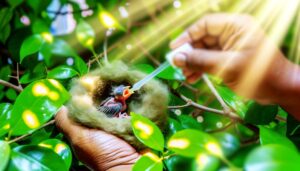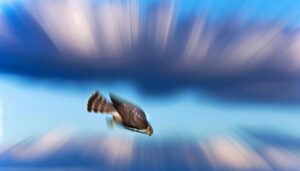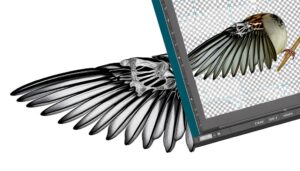7 Essential Steps to Help a Sparrow That Can’t Fly
If you find a sparrow that can't fly, begin by calmly evaluating its condition for signs of trauma or injury. Wear gloves for safety and approach the bird quietly.
Gently examine its wings, legs, and body for wounds or fractures. Create a warm, quiet shelter lined with soft cloths, ensuring proper ventilation.
Provide easy access to water and a nutritious mix of seeds, fruits, and insects. Closely monitor the sparrow's condition, noting any changes in behavior, appetite, or movement.
Contact local wildlife experts or rehabilitation centers for professional advice and follow their guidance. Further details will enhance your rescue efforts.
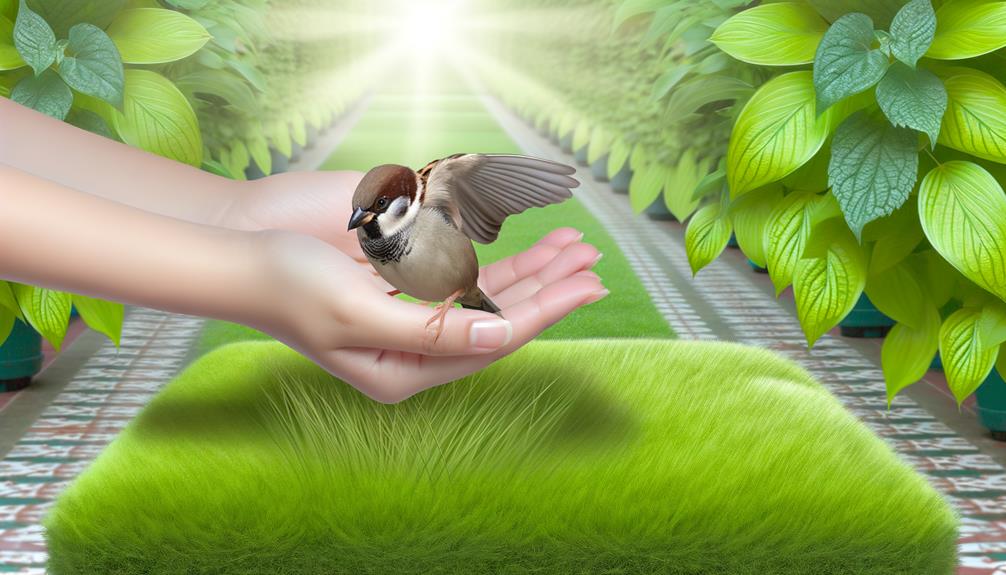
Key Takeaways
- Assess the sparrow for visible injuries, trauma, or signs of illness.
- Create a safe, warm shelter lined with soft materials and ensure proper ventilation.
- Offer nutritious food like seed mix, fruits, vegetables, and insects, and provide shallow water containers.
- Monitor the sparrow's condition closely for any changes in behavior, appetite, or health.
- Contact local wildlife rehabilitators or avian veterinarians for expert guidance and follow their advice.
Assess the Situation

Upon encountering a sparrow that cannot fly, the first step is to carefully observe its behavior and physical condition to understand the extent of its injury or distress.
Examine the bird's wings for any visible signs of trauma, such as broken feathers or misalignment. Additionally, note if the sparrow is favoring one leg or exhibiting labored breathing, which could indicate further complications.
Observe the bird's movement—is it hopping or dragging its body? This can provide vital insights into its overall health. Look for any signs of external parasites or wounds.
Documenting these observations will help in determining the best course of action. Understanding the specific nature of the sparrow's condition is important for providing appropriate care and improving its chances of recovery.
Approach the Sparrow Carefully
When approaching a sparrow that is unable to fly, it is vital to observe its behavior closely to gauge its level of distress and potential injuries.
Use gentle, slow movements to avoid startling the bird, which can cause additional stress or injury.
Additionally, guarantee your personal safety by wearing gloves to protect against potential bites or diseases.
Observe Its Behavior
Approaching the sparrow carefully, observe its behavior to assess its condition and determine the best course of action for its well-being. Look for signs of injury, such as visible wounds, unnatural wing positions, or difficulty in movement.
Note the bird's responsiveness: Does it react to your presence with alertness, or does it appear lethargic and unresponsive? A healthy sparrow might still attempt to hop or flutter, while an injured one may remain stationary.
Assess the environment for potential threats or hazards that could be causing distress. Additionally, consider whether the sparrow might be a fledgling learning to fly, which could explain its temporary grounded state.
Thorough observation is vital for making informed decisions about the sparrow's care.
Use Gentle Movements
Carefully and steadily, approach the sparrow to minimize stress and prevent further injury. Maintaining a calm demeanor is essential, as sudden movements can startle the bird, exacerbating its distress. Utilize gentle, slow gestures to reassure the sparrow of your benign intentions. This approach will enable you to assess its condition without causing additional harm.
Approach quietly: Noise can frighten the bird, so move silently.
Use slow movements: Quick actions can startle and stress the sparrow.
Keep a low profile: Crouch down to appear less intimidating.
Avoid direct eye contact: This can be perceived as a threat.
Speak softly: If you must communicate, use a soothing tone.
These steps will help create a comforting environment for the sparrow.
Ensure Personal Safety
To secure your safety while helping the sparrow, it is important to be mindful of your surroundings and the potential risks involved. Approach the bird slowly and avoid sudden movements that might startle it. Wear gloves to protect yourself from potential scratches or bites, as even small birds can cause injury when frightened.
Confirm the area is free from hazards such as traffic, predators, or other disturbances that could escalate the situation. Additionally, be cautious of zoonotic diseases that birds can carry.
If you feel unsure or unsafe at any point, contact a local wildlife rehabilitator for professional assistance. By taking these precautions, you can provide aid to the sparrow while securing your own safety.
Check for Injuries
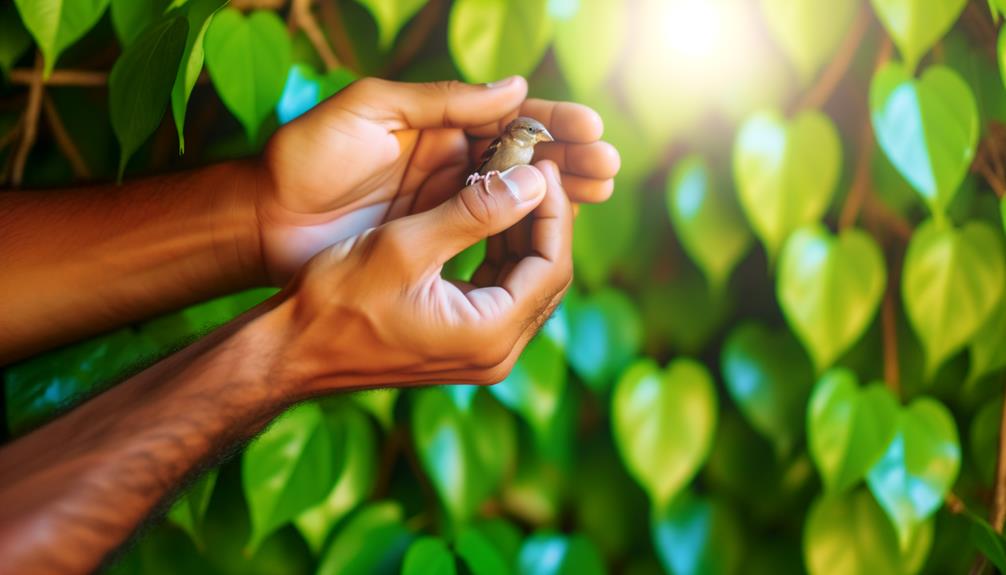
When assisting a sparrow that cannot fly, it is important to first examine the bird for any visible signs of injury. Conduct a thorough, yet gentle, inspection to identify any physical issues that may be preventing flight. Look for:
- Broken or misaligned wings: Gently extend each wing to check for irregularities.
- Bleeding or open wounds: Inspect the body and wings for any open cuts or blood.
- Swelling or bruising: Feel for unusual lumps or discoloration on the bird's body.
- Signs of infection: Observe for redness, pus, or unusual discharge around wounds.
- Leg injuries: Check the legs and feet for fractures or deformities.
Identifying these issues early can guide the appropriate care and intervention needed for the sparrow's recovery.
Create a Safe Space
After identifying any injuries, the next step in aiding the sparrow's recovery is to create a safe and comfortable environment for the bird.
Select a quiet, warm location indoors, away from pets and potential disturbances. Line a small box or a pet carrier with soft, clean cloths to provide cushioning and warmth.
Guarantee the box has ventilation holes for airflow but is secure enough to prevent the sparrow from escaping and further injuring itself. Maintain a consistent temperature, ideally around 75-80°F (24-27°C), to help the bird remain calm and reduce stress.
Keep the environment dimly lit to mimic the natural setting, which aids in the sparrow's relaxation and healing process.
Provide Temporary Shelter

When providing temporary shelter for an injured sparrow, it is essential to weigh safe containment options that prevent further harm while allowing for observation and care.
Suitable shelter materials, such as soft fabrics and breathable containers, can offer comfort and security during the bird's recovery period.
Ensuring these elements are in place will greatly enhance the chances of a successful rehabilitation.
Safe Containment Options
To provide a temporary shelter for a sparrow that cannot fly, it is crucial to create a safe and comfortable environment using a well-ventilated box or small cage lined with soft materials. This containment will protect the bird while guaranteeing it has adequate space and ventilation. Make sure the shelter is placed in a quiet, warm area away from pets and loud noises.
Consider the following when setting up the temporary shelter:
- Ventilation: Make certain the box or cage has sufficient air holes.
- Security: Use a secure lid to prevent escape while still allowing airflow.
- Soft Lining: Line the bottom with soft cloths for comfort.
- Location: Place the shelter in a calm, warm area.
- Accessibility: Guarantee easy access for feeding and cleaning.
Suitable Shelter Materials
Selecting appropriate materials for the temporary shelter is crucial in guaranteeing the sparrow's comfort and well-being. Use a small cardboard box or a plastic container with ventilation holes. Line the bottom with soft, absorbent materials such as paper towels, cloth, or shredded paper to create a cushioned environment.
Avoid using cotton, as it can entangle the sparrow's feet. Ensure the shelter is kept in a warm, quiet, and dimly lit area to minimize stress. Additionally, provide a small dish of water and some birdseed, placing them in shallow containers to prevent drowning hazards.
Regularly check the shelter to maintain cleanliness and comfort, ensuring the sparrow has a secure and nurturing space for recovery.
Offer Fresh Water
Providing fresh water is necessary for the well-being of a sparrow that cannot fly, as it guarantees proper hydration and aids in its recovery. Making access to clean water is essential for its overall health and strength.
Place a shallow dish with fresh water within easy reach of the sparrow to prevent further strain or injury. Regularly replace the water to maintain hygiene and prevent contamination.
- Use a shallow dish: This makes it easier for the sparrow to drink and reduces the risk of drowning.
- Keep water fresh: Change it daily to prevent bacterial growth.
- Monitor intake: Make sure the sparrow is drinking regularly.
- Avoid deep containers: These can be hazardous.
- Position wisely: Place the dish in a quiet, secure area.
Prepare Nutritious Food
Ensuring the sparrow receives a balanced and nutritious diet is vital for its recovery and overall health. Begin by providing a mixture of seeds such as millet, sunflower, and safflower, which are rich in essential nutrients.
Supplement this with small amounts of fresh fruits and vegetables like diced apples, peas, and carrots to provide vitamins and minerals. Insects like mealworms can offer a protein boost, important for muscle repair and energy.
Avoid feeding the bird bread or milk, as these can cause digestive issues. Make sure the food is finely chopped to facilitate easy consumption.
Regularly replace uneaten food to maintain hygiene and prevent bacterial growth, promoting a safe and conducive environment for the sparrow's recuperation.
Monitor the Sparrow's Condition
Regular and careful observation of the sparrow's condition is essential to guarantee its recovery progresses smoothly and to promptly address any emerging health concerns. Consistent monitoring allows for early detection of potential issues such as infection, dehydration, or worsening injuries.
Here are key aspects to focus on:
- Physical Appearance: Check for any changes in feathers, eyes, or skin.
- Behavior: Note any alterations in activity levels or signs of distress.
- Appetite: Ensure the sparrow is eating and drinking regularly.
- Waste: Observe the frequency and appearance of droppings to assess digestive health.
- Movement: Monitor improvements or setbacks in mobility, even subtle ones.
Contact a Wildlife Expert
When encountering a sparrow that cannot fly, contacting a wildlife expert is essential. Begin by identifying local wildlife rehabilitators or organizations equipped to handle avian care.
Be prepared to provide detailed information about the sparrow's condition, including any visible injuries, behaviors, and the environment in which it was found.
Identifying Local Experts
Consulting a wildlife expert is crucial when you come across a sparrow that cannot fly, as these professionals possess the expertise necessary to provide the best care and intervention.
Identifying local experts involves a few key steps:
- Contact Local Wildlife Rehabilitation Centers: These centers specialize in the care of injured or orphaned wildlife.
- Reach Out to Veterinarians: Some veterinarians have experience with wild birds and can offer immediate advice or referrals.
- Check with Local Animal Shelters: They often have connections with wildlife experts and can guide you.
- Consult Bird Watching Groups: Members frequently have knowledge of local wildlife resources.
- Search Online Directories: Websites and social media can help you find qualified wildlife rehabilitators in your area.
Taking these steps guarantees the sparrow receives appropriate care.
Necessary Information to Provide
To ensure the wildlife expert can offer the best possible assistance for the injured sparrow, it is vital to provide detailed and accurate information about the bird's condition and circumstances. Include observations such as visible injuries, behavior, and current location. Noting the time and weather conditions can also be critical. Here's a table to guide you:
| Information Type | Example Details |
|---|---|
| Visible Injuries | Broken wing, bleeding, disoriented |
| Behavior | Unable to fly, lethargic, alert |
| Current Location | Backyard, near a tree, on pavement |
Follow Expert Advice
Seeking advice from bird specialists is essential to make sure the sparrow receives appropriate care and has the best chance of recovery. Consulting professionals guarantees that the bird's specific needs are met, minimizing potential harm and increasing recovery chances. Experts can provide tailored recommendations, whether it involves dietary adjustments, medical treatment, or habitat modifications. Their guidance is indispensable, given their in-depth knowledge and experience.
To effectively follow expert advice:
- Contact a local wildlife rehabilitation center for professional guidance.
- Seek recommendations from avian veterinarians who specialize in bird care.
- Utilize reputable online resources and forums dedicated to bird rescue.
- Follow any prescribed treatment plans diligently.
- Observe the sparrow closely and report any changes to experts.
Securing expert involvement maximizes the sparrow's prospects for a swift, safe recovery.
Plan for Release or Long-Term Care
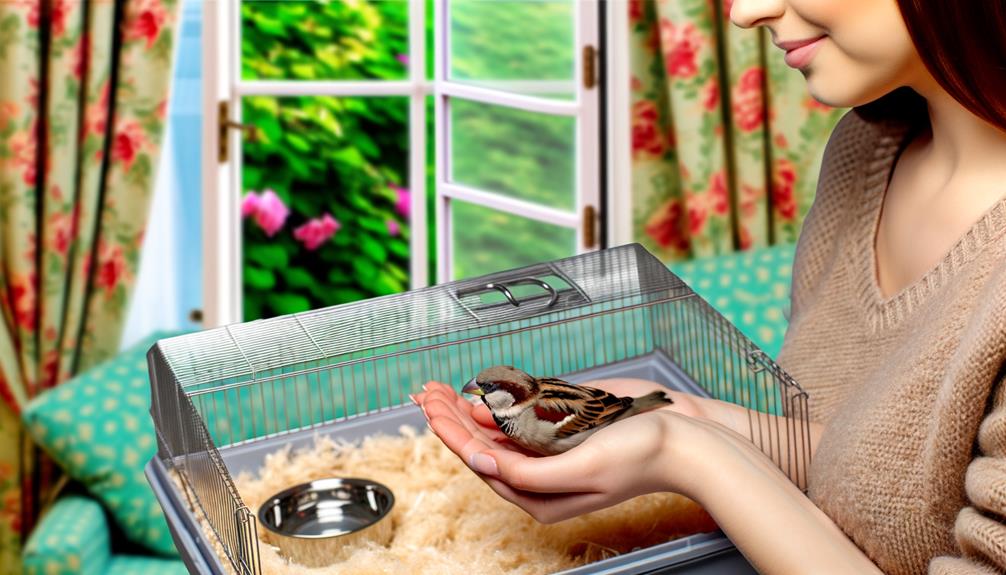
After receiving appropriate treatment and care as advised by experts, the next step involves determining whether the sparrow can be released back into the wild or requires long-term care.
Observe the bird for signs of strong, consistent flight and normal behavior indicative of readiness for release. If the sparrow exhibits difficulties, consult with a wildlife rehabilitator to assess its condition.
In cases where recovery is incomplete or permanent disability exists, consider long-term care options. This may involve specialized housing that simulates a natural environment while ensuring safety from predators.
Always prioritize the sparrow's well-being, and collaborate with professionals to make informed decisions, ensuring the bird receives the best possible outcome whether in the wild or under human care.
Conclusion
In addressing a sparrow that cannot fly, thorough assessment and careful handling are paramount. Injuries must be identified, and a secure environment provided to guarantee safety. Continuous monitoring is essential, along with consulting wildlife experts for specialized guidance.
Adhering to expert recommendations will facilitate either the bird's release or appropriate long-term care. As the adage goes, 'A stitch in time saves nine,' underscoring the importance of timely and meticulous intervention to safeguard the sparrow's well-being.




